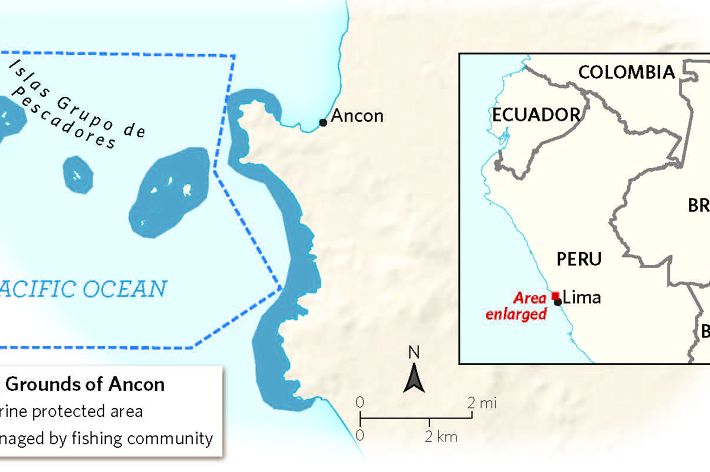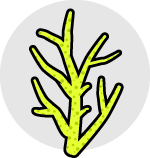
Ray of Hope
After years of widespread coral die-offs, teams of marine scientists in Florida are learning how we may be able to replant reefs.
Summer 2019
Off the back of a chartered dive boat in Dry Tortugas National Park in the Gulf of America, Caitlin Lustic and a half-dozen other divers run through their game plan one last time. Then, one by one, they silently slip below the surface and begin ferrying colorful milk crates full of precious cargo toward the damaged coral reefs below.
The crates are filled with cuttings of young staghorn coral that have been carefully tended in an underwater nursery until they are strong enough for “outplanting” here, where many of the reefs have started looking colorless and dead. The dive team—led by Lustic, The Nature Conservancy’s marine conservation manager for South Florida, and composed entirely of women—will put in a full day underwater, getting the corals settled in their new home.
The process is both beautiful and decidedly unromantic. The divers move in a graceful, slow-motion ballet, seeking the perfect spot among sea fans swaying softly in the gulf’s surges. Then they use hammers to pound steel nails into the reef and swiftly zip tie the baby corals to the nails to ensure that they are securely anchored against currents, tides and hurricanes.
This expanse of water and the cluster of seven nearby islands, collectively known as Dry Tortugas National Park, is a remote and legendary place. Located 70 miles west of Key West, it can be reached only by boat or seaplane, and it has been a strategic Civil War-era chokepoint, a stomping ground for Ernest Hemingway and a landing spot for Cuban refugees.
The Dry Tortugas also lies at the farthest reaches of the Florida Reef Tract, a vast chain of coral reefs that stretches some 360 linear miles to St. Lucie Inlet on Florida’s Atlantic coast. But even their remoteness hasn’t entirely protected the Dry Tortugas’ reefs from the same threats facing corals all around the world.
During last summer’s dive trip, Lustic and representatives from several partner organizations spent a week “planting” 1,200 young corals on reefs within the national park. The project was the latest chapter in a long-running effort to stanch the loss of corals not just in Florida, but throughout the Caribbean. Since the late 1980s, populations of staghorn, elkhorn and other corals have declined by as much as 97 percent in the United States and the Caribbean. Those losses have been driven by high water temperatures, disease, changes in seawater acidity, hurricanes, and local impacts such as agricultural runoff and sewage discharges into the ocean.
But the widespread loss of corals has also spurred a far-reaching effort to save them. Since 2004, TNC and its partners have been working to restore coral throughout the entire Florida Reef Tract. This trip to the Dry Tortugas—which included partners from the Florida Fish and Wildlife Conservation Commission’s Fish and Wildlife Research Institute, Florida Institute of Technology, the University of Miami and the Coral Restoration Foundation—was part of that broader effort. The Conservancy and the National Park Service established an underwater coral nursery at the park in 2010.
Lizzie McLeod is TNC’s global reef systems lead scientist. She says restoration work along the Florida Reef Tract reflects an increasing trend regarding similar reef ecosystem efforts around the world. “When the restoration effort began, it was focused on ‘coral gardening’ and replacing a particular vulnerable coral [species] into the reef,” says McLeod. Now, she says, the effort is shifting from restoring individual species to working to restore the health of the entire ecosystem.
Lustic says that growing and planting coral can seem like a lot of effort to the uninitiated. But the beauty of a living reef is its ability to grow and weather the powerful forces of the ocean. Coastal reefs reduce incoming wave energy by 97 percent, which helps protect onshore communities. And there’s simply no artificial substitute for live coral, the heart of an intricate ecosystem that spreads far beyond the reef itself and into the open ocean, supporting thousands of fish and other sea life.
With the restoration effort, McLeod, Lustic and their colleagues are hoping to jump-start healthy coral populations that—with a little luck—can stand up to the changing conditions driven by climate change and other threats. Right now, surviving wild coral colonies are too isolated from each other to effectively interbreed. But by planting corals in places that will ultimately allow coral to reproduce on their own, scientists hope to gradually push ailing reefs back to the point where they can restore themselves.
“The idea has always been to encourage them to spawn and recolonize the reef themselves,” says Lustic. And “the more sexual recombination we get, the better. We want to keep things recombining so we get stronger corals over time.”
From a Few to Many
Using a process called fragmentation, marine scientists can grow multiple new corals from just one piece.
Throughout the Florida Reef Tract, the restoration effort has been growing. In recent years, more than 50,000 corals have been housed in more than half a dozen nurseries, and more than 10,000-plus have been planted on damaged reefs.
This work has been a catalyst for a more ambitious effort worldwide. The Conservancy has helped establish coral nurseries in the U.S. Virgin Islands, British Virgin Islands, Grenada, the Bahamas, the Dominican Republic and Cuba, and is carrying out a large-scale remote sensing project to better understand the ecological and economic benefits of coral reefs in the Caribbean, evaluate the impact of tropical storms and monitor the effectiveness of coral restoration.
“We’ve grown from site-based work to really having a global footprint,” McLeod says. “Right now, we’re working in more than 30 countries. We reach managers in over 75 percent of the world’s reef countries.”
Planting Coral



Repopulating reefs with nursery-grown coral is a labor of love. But Lustic says that coral restoration partners are often heartened by seeing their nursery-raised corals growing up in the wild. “Finding these old colonies—that’s really cool,” she says. “Oh my gosh: This thing’s six years old and it’s huge, and it looks awesome. That’s what keeps everyone going.”
Yet McLeod warns that the world’s coral reefs faces significant challenges in the future. More than half of the world’s coral has been lost in the past three decades, and scientists say that globally, the largest culprit is warming seas driven by climate change and exacerbated by El Nino and La Nina events. “I think people are realizing: This is all hands on deck—every tool in the toolbox.
“Getting global warming under control is essential for reefs to have a future,” she says. “We still have a window of opportunity to turn things around, and the next decade is mission critical to do that.”






